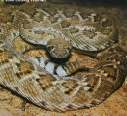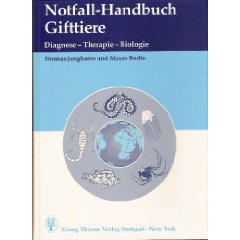|



| |
Crotalus scutulatus


Namen: Mojave-Klapperschlange; Mojave Rattlesnake, Mojave
Green Rattlesnake
Unterarten, Namen und Vorkommen:
- Crotalus scutulatus salvini
- Huamantlan Rattlesnake; Lokale Namen:
Chiauhcoatl de Salvin, Chiauhcoatl, Vibora, Vibora de Cascabel
- Mexiko (Tlaxcala, Puebla, Hidalgo, Westzentral-Veracruz)
- Crotalus scutulatus scutulatus
-

- Northern Mojave Rattlesnake; Lokale Namen:
Cascabel Llanera, Chiauhcoatl, Vibora, Vibora de Cascabel
Alte Namen:
- Crotalus scutulatus scutulatus
- Caudisona scutulata
- Crotalus confluentus kellyi
- Crotalus scutulatus salvini
Vorkommen: USA (Süd-Kalifornien, Süd-Nevada, Arizona, Süd-New Mexico, West-Texas),
Mexiko (Nord-, Ost-Sonora, Chihuahua, West-, Süd-Coahuila, Durango, Zacatecas, San Luis
Potosi,
Süd-Nuevo Leon, West-Tamaulipas, südlich bis Süd-Puebla).
Beschreibung: Die
Mojave-Klapperschlange ist eine mittelgroße Klapperschlange mit einer maximalen
Körperlänge von etwa einem Meter. Die typische Grundfärbung ist grünlich,
olivgrün, braun, gelbbraun oder gelb mit abgewinkelten Flecken als
Rückenzeichnung. Die Flecken sind im Regelfall gut gegeneinander abgegrenzt und
deutlich erkennbar. Der Schwanz besitzt eine schwarz-weiß-Streifung, bei der die
weißen Streifen deutlich breiter sind als die schwarzen.
Toxine: Es existieren zwei
verschiedene Zusammensetzungen der Toxine. Diese lassen sich durch die
räumlichen Strukturen unterscheiden. "Typ A"-Gift enthält "Mojave
Toxin". Dabei handelt es sich um ein Neurotoxin. Dieser Typ enthält keine
proteolytischen und hämorrhagischen Giftbestandteile. "Typ B"-Gift hat keine
neurotoxische Komponente, aber die proteolytischen und hämorrhagischen
Giftbestandteile.
Symptome: An der Bissstelle kommt
es zu starken lokalen Schmerzen und Schwellungen. Des weiteren entsteht eine
Blasenbildung und Nekrosen. Allgemeine Zeichen sind Übelkeit, Erbrechen,
abdominelle Schmerzen, Durchfall und unkontrollierter Abgang
von Stuhl. Der Blutdruck kann stark abfallen. Blutgerinnungsstörungen (fibrinolytische
Wirkung) sind Zeichen für das "Typ B"-Gift. Bei Typ A-Gift "Mojave Toxin" ist
eine
Ptosis ein Zeichen für die neurotoxische Wirkung. Eine Blasenbildung tritt nicht
auf.
Maßnahmen:
Die pressure-immobilization-Methode darf nicht
angewendet werden. Die betroffene Stelle ist ruhig zustellen. Der Patient muss
liegend in eine Klinik transportiert werden. Bei einem Blutdruckabfall sind
große Flüssigkeitsmengen zu infundieren. Die weiteren Maßnahmen bis zur Klinik
erfolgen symptomatisch. Bei einem Blutdruckabfall ist Flüssigkeit zu
infundieren. Es existiert ein Antivenin (CroFab). Die Gabe ist mit einer
Giftnotrufzentrale abzustimmen.
Literatur:
-

-
The Reptile Database
-
WCH Clinical Toxinology
-
WCH Clinical Toxinology
-
Toxikologische Abteilung, Klinikum Rechts der Isar, München
-
Isolation and characterization of two disintegrins inhibiting ADP-induced
human platelet aggregation from the venom of Crotalus scutulatus scutulatus (Mohave
Rattlesnake).
-
Disintegrin, hemorrhagic, and proteolytic activities of Mohave rattlesnake,
Crotalus scutulatus scutulatus venoms lacking Mojave toxin.
-
Mojave rattlesnakes (Crotalus scutulatus scutulatus) lacking the acidic
subunit DNA sequence lack Mojave toxin in their venom.
-
Mojave rattlesnake (Crotalus scutulatus scutulatus) identification.
-
Successful treatment of crotalid-induced neurotoxicity with a new polyspecific
crotalid Fab antivenom.
-
Mojave rattlesnake envenomation in southern California- a review of suspected
cases.
-
A phospholipase A2-like pseudogene retaining the highly conserved introns of
Mojave toxin and other snake venom group II PLA2s, but having different exons.
-
Genomic sequences encoding the acidic and basic subunits of Mojave toxin-
unusually high sequence identity of non-coding regions.
-
Hemorrhagic and Mojave toxins in the venoms of the offspring of two Mojave
rattlesnakes (Crotalus scutulatus scutulatus).
-
Mojave toxin affects fusion of myoblasts and viability of myotubes in cell
cultures.
-
Variation in the antigenic characteristics of venom from the Mojave
rattlesnake (Crotalus scutulatus scutulatus).
-
Mojave rattlesnake (Crotalus scutulatus scutulatus) venom- in vitro effect on
platelets, fibrinolysis, and fibrinogen clotting.
-
Amino acid sequence of the basic subunit of Mojave toxin from the venom of the
Mojave rattlesnake (Crotalus s. scutulatus).
-
Isolation of a hemorrhagic toxin from Mojave rattlesnake (Crotalus scutulatus
scutulatus) venom.
-
Venom characteristics as an indicator of hybridization between Crotalus
viridis viridis and Crotalus scutulatus scutulatus in New Mexico.
-
Factors in snake venoms that increase capillary permeability.
-
Inhibition of calcium channel dihydropyridine receptor binding by purified
Mojave toxin.
-
Intergradation of two different venom populations of the Mojave rattlesnake
(Crotalus scutulatus scutulatus) in Arizona.
-
Mojave toxin- rapid purification, heterogeneity and resistance to denaturation
by urea.
-
Fatal rattlesnake envenomation in Arizona- 1969-1984.
-
Characterization of two arginine ester hydrolases from Mojave rattlesnake
(Crotalus scutulatus scutulatus) venom.
-
The distribution among ophidian venoms of a toxin isolated from the venom of
the Mojave rattlesnake (Crotalus scutulatus scutulatus).
-
Isolation of two phospholipases A2 from Mojave rattlesnake (Crotalus
scutulatus scutulatus) venom and variation of immunologically related venom
proteins in different populations.
-
Electrophoretic variants of Mojave rattlesnake (Crotalus scutulatus scutulatus)
venoms and migration differences of Mojave toxin.
-
Mojave rattlesnake (Crotalus scutulatus scutulatus) venom- enzyme activities
and purification of arginine ester hydrolases.
-
Isolation of an anticomplement factor from the venom of the Mojave rattlesnake
(Crotalus scutulatus scutulatus).
-
Geographical variation in Crotalus scutulatus scutulatus (Mojave rattlesnake)
venom properties.
-
Envenomation by the Mojave rattlesnake (Crotalus scutulatus scutulatus) in
southern Arizona, U.S.A.
-
The dual nature of complement enhancement by venom from the Mojave rattlesnake
(Crotalus scutulatus scutulatus).
-
Presynaptic actions of Mojave toxin isolated from Mojave rattlesnake (crotalus
scutulatus) venom.
-
Sites of action of Mojave toxin isolated from the venom of the Mojave
rattlesnake.
-
Mojave-Klapperschlange – Wikipedia
-
Mojave-Klapperschlange - Tierdoku
-
Informationszentrale gegen Vergiftungen- Crotalus scutulatus ...
-
Giftschlangen- Mojave-Klapperschlange -- GORUMA
-
Mohave Rattlesnake (Crotalus scutulatus) - Reptiles of Arizona
|